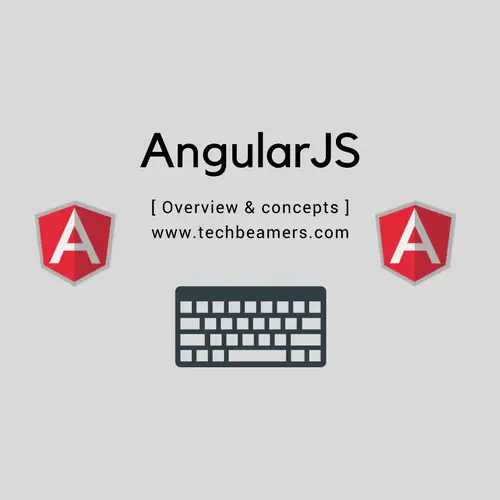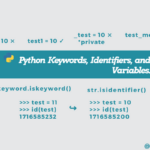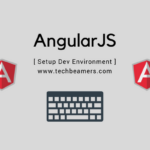In this post, we’ve brought up a detailed AngularJS overview for web developers who are planning to become full-stack developers. Here, you’ll get to learn about the essential elements of a web application created using AngularJS.
AngularJS is a Javascript-based framework, widely used for building the client side of any web application. It is created and maintained by Google and a community of individuals. It helps in resolving the challenges faced by the developers while developing single-page applications.
AngularJS is based on the MVW ( stands for Model-View-Whatever) model. It provides the flexibility to choose the design pattern for developing the application. It allows the use of a set of markups. These enable automatic synchronization between HTML and JavaScript. It helps the developer focus on writing the application logic. He does not need to concentrate on updating the views manually, anymore.
If you like to brush up on Angular concepts quickly, then go through the below post once.
100+ AngularJS Interview Questions
AngularJS is open-source, completely free, and widely used by developers all around the world. It gets the license under the Apache License version 2.0. Whether we intend to extend an existing JavaScript application or create a rich and interactive SPA, AngularJS helps in both cases, by writing more efficient code. Let’s look at the Core Features of AngularJS that play a vital role in its popularity in the web development domain.
AngularJS Overview: Essential Concepts.

Data-binding
It is responsible for automatic data synchronization, between model and view components.
Scope
These objects act as a reference to the model. They work as a binding between the controller and the view.
Controller
These are functions written in JavaScript. It is bound to a particular scope.
Services
AngularJS defines several built-in services. For example, $https is used for making XMLHttpRequests. These are singleton objects that get instantiated only once in an application.
Filters
It selects a subset of items from an array and returns a new collection.
Directives
AngularJS provides the capability to extend HTML using new attributes called Directives. However, it also has a set of, built-in Directives. These Directives, provide the support of different useful functionalities to an application. <ng-app>, <ng-init>, and <ng-model> are some of the widely used Directives. We can even create Directives ourselves in AngularJS.
Templates
These are the rendered views that a user sees in the browser. It gets the information from the controller and model. It can be a single file (like index.html) or multiple views on one page.
Routing
It is the concept of switching views.
Model View Whatever
MVC is a design pattern. It splits an application into different parts called Model, View, and Controller. Each of them has discrete responsibilities. AngularJS does not implement MVC in its conventional way, but something closer to MVVM (Model-View-ViewModel). Whimsically, the AngularJS team calls it Model View Whatever.
Deep Linking
This feature provides the support to encode the state of an application in the URL. In this way, the application gets bookmarked. Using that URL, we can restore the application to its same state.
Dependency Injection
AngularJS has a built-in dependency injection subsystem. It helps the developer by making it easier to, develop, understand, and test an application.
AngularJS Overview: Pros/Cons.
We outlined most of the pros and cons of AngularJS and highly recommend you read these.
AngularJS Pros
- It facilitates the developer to create an easily maintainable single-page application.
- AngularJS provides data binding capability to HTML thus providing immediate response to the user on the view when data changes and vice versa.
- AngularJS code is unit-testable, which is its very compelling competitive advantage.
- With the Dependency Injection feature, the developer does not need to search for dependencies or add them himself. The framework detects them automatically, just by adding a little info.
- AngularJS provides reusable components.
- With AngularJS, the developer writes less code and gets more functionality. Coding Data models are simpler with AngularJS. Moreover, it provides Data Binding, that reduces the instructions required to put the data in the view, manually. AngularJS also provides Directives, which are separate from the app code. Thus, allowing a different team to work on it simultaneously.
- AngularJS directs to split the application into multiple MVC components. As soon as the splitting is finished, AngularJS does the rest of the functions by itself. It saves us from the trouble of writing another code to bind these MVC components again.
- Most importantly, AngularJS applications can run on all major browsers and smartphones including Android and iOS-based phones/tablets.
AngularJS – Cons
- The libraries must belong to AngularJS. The framework does not work very well, with tools or libraries that are not AngularJS specific.
- An application written in AngularJS is not safe, as it’s a JavaScript-based Framework. Authentication and authorization must be done on the Server side to keep the app secure.
- The framework works in a complicated manner. Only an experienced person can understand it and work on it.
- If the user somehow happens to disable the JavaScript in the application, then he will just see the original page and nothing more.
- AngularJS implementations scale poorly. It means that, as the project grows, the developer may wish to delete the existing code and create new versions using different approaches.
If you liked the above AngularJS overview, then don’t mind sharing it further. Also, follow us on our social media accounts.








